Lafayette Anticipation associate curator Anna Colin talks to artist Tyler Coburn about Ergonomic Futures, a speculative project engaged with art, design, science, anthropology and writing. In this interview, Coburn discusses the research, production process and network of collaborators of a multilayered project ultimately concerned with the futures of humankind. Anna Colin: When one comes across your museum seats Ergonomic Futures (2016—) in contemporary art exhibitions—and soon in natural history, fine art, and anthropology museums—they look… [read more »]
Interview with MPA: “Directing Light onto Fist of Father” by Courtney Malick
INTERVIEW WITH MPA, OCT 5, 2011
“Directing Light Onto Fist of Father”
Leo Koenig, September 15-November 12, 2011
Co-Curated by Alhena Katsof and Dean Daderko
MPA is a New York based performance artist who has been presenting challenging and visceral work that includes drawing, photography, installation and collaborations throughout New York and abroad for the past seven years. She is currently in the middle of her first solo exhibition at Leo Koenig Gallery in NYC entitled “Directing Light Onto Fist of Father”, which opened on September 15th and runs through November 12th.
The exhibition is comprised of many performances and live interventions within the gallery space that unfold in a narrative chain that resembles the flow of give and take within conversational exchange. Like many of MPA’s previous projects, “Directing Light…” explores the personal and political potential of the presence of the body (or bodies) in space. In this case the body is first and most boldly represented by the symbol of the fist, which she has caste in plaster and stands for Father. For MPA the Father is both a personal as well as a universal figure and thus manifests as a physical embodiment upon which to consider power, as it is obtained, possessed and wielded.
I had the pleasure of interviewing MPA to find out more about this project and what is in store for the second half of the show, as she moves through its three stages, “Initiation”, “The Act” and “The Invitation”.
—Courtney Malick
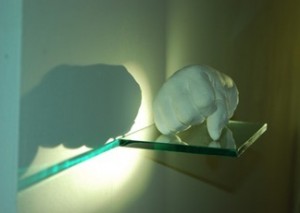
CM: I am wondering about the order of the “phases” of this show and the titles for each. The first is called “Initiation”, which makes sense. Can you say something first about this performance, since I wasn’t there to experience it?
MPA: “Part I: Initiation” happened Sept 15th 6–8p. I stood next to a glass shelf with my eyes shut holding a plaster cast of my father’s fist as the public passed in and out of the space. I wore the jeans I wear everyday and a white ribbed tank-top. I remained still for 2.5 hours. Over this time the room shifted from quiet to loud and crowded. From my position, I went in and out of my body. I meditated, thought about the fist, thought about power. I felt rendered – colored in — by the presence of the audience, and although my eyes were closed I knew when someone was close or when there was space. Occasionally a familiar laugh or voice would bring me back into the room to listen more literally – details to an audio picture I was forming. An active composition.
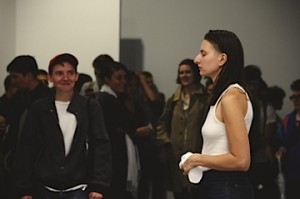
At 8pm the curators whispered into my ear that it was 8. I continued to stand and intended to keep standing. The room was noisy and full. A silence grew. A silence grew, the silence felt like a request. I felt a very strong energy – a focus. And this energy met my stationary, still body and had me open my eyes. A silence that acted as a calling.
I opened my eyes to a room full of staring people. My eyes didn’t quite work, and my mouth was parched. I remember blinking — almost loudly. I turned my head and looked into the eyes of each person looking at me. Some eyes were wet. One person was crying. The moment, now past, I can say was surreal. The energy and focus in the room still feels to me as if it was a dream. Perhaps a kind of waking. A beginning. An initiation.
I said “Thank you for standing with me” and I walked slowly into the back room of the gallery.
My standing felt layered – a form of protest. A demonstration. A meditation. A room composed of energy generated by the audience, I felt active without visible movement.
I wrote a friend afterward:
‘I thought about holding power and about ‘em bodies meant of power. I listened.
I felt potential
to direct light
onto the fist
onto each other”
Two days later Occupy Wall Street began, and I joined in ever enthusiastically.
CM: The second “phase” is called “The Act” and the third, “The Invitation”. This I find interesting and kind of surprising — that the ‘invitation’ would come at the end, rather than the beginning… Are these performances meant to be understood as some kind of a narrative that builds over the course of the show and if so is there a specific reason you had in mind for ending that “narrative” with an invitation?
MPA: The three phases do suggest a narrative or timing to a conversation with light and the/a fist of father. Past, present, and future are considered in the three parts and the installation of the space. In the back corner, a 16mm film of directed light tracing the contours of the fist behaves like an object of the past. It is a projection of past moment. Time is pulled behind and pushed forward in this moment and in the arrangement of this projection (bouncing off a mirror to spread across the wall). Also, in this corner is a pile of ground yellow Tumeric on a glass shelf. The placement of the Tumeric draws an immediate line to the yellow painting(s) at the front of the space. Tumeric is a root, (it looks like a ginger root), with many cleansing properties. The ground Tumeric echoes the dry yellow pigment at the root of paints and painting. I view that back corner as a dissection of what is happening at the front of the space. The back corner is dimly lit and moody. The front of the space is appropriately lit and cleanly accented. The entire space is very minimal, and I experience it as a site, remnants in a trail that can lead the viewer to investigate the power dynamics represented in “the fist of father”. The fist of father is symbolic of and connotes many themes, amongst them are master/mastery, rule of law, and patriarchy.
Specific to “Initiation”, “The Act”, and “Invitation”, the considerations for past, present and future continue. “Initiation” implies the beginning but it also relied on ingredients of the past. I stood in meditation in a present moment but my mind went in and out of memories of family and experiences with power. “Initiation” is also intended to infuse the site and the plaster fist with energy from the viewers that is then carried into the next act. Each part informs the next.
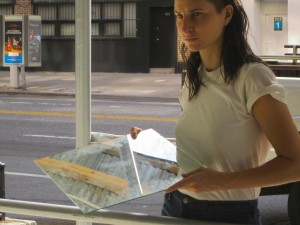
“The Act” is directing light onto the fist and happens any sunny day. To direct light I stand outside the gallery in between the sun and the fist, two objects with associations to the HERO, and hold a mirror directing the sunlight into the space. The mirror is a bridge to the light but also a SIGNAL. I am sending a signal between two sources of power. It is also taking a signal from nature (the sun) and sending it into what is man-made (the gallery, the plaster fist, art).
“The Act” relies on the weather and makes this action very immediate. The passing of a cloud or a rainy day informs this conversation, and so it is not predetermined. It is very Present.
Last week, I placed a sign on the door:
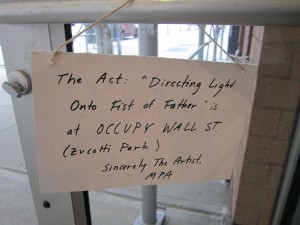
“Invitation” extends the conversation with the fist, a symbol of power outside of myself, and invites Amapola Prada to join me in the discussion. We will present the piece, “Revolution: Two Marks in Rotation”, on November 8th in the space. Our work tends to rely on energy associated with future notions of time, or psychic impulses. Another word might be Projections.
CM: What can you tell me about Amapola Prada? I know the two of you have worked together for the past six years. What kinds of similarities or differences do you see between your work and hers? Why have you decided after working together privately for the past six years to use this show as an opportunity to present your collaborative work publicly?
MPA: Amapola and I first met in 2007 in Oaxaca, Mexico. We were both there to work with Guillermo Gomez-Pena in a performance workshop. At that time the Governor of Oaxaca had fled the city as the result of protests initiated by the student and teacher movement that extended to farmers and the Zapatistas in the neighboring hills. This is where our friendship began and over the years I have visited Amapola in Mexico and Peru (her home). She is now here in New York via a grant from Franklin Furnace, working on a piece that will show at the AC Institute.
We both use performance to exercise or put action to thought/theory. There is a strong commitment from us both for endurance and confronting limitations, both physically and conceptually. For this piece, we are looking at the power dynamics within our own relationship. I invited Amapola to join me in “Directing Light Onto Fist of Father” and she asked me, “Where is the fist in you?”
That question is an address. It speaks to the power that I inherit. To the power, violence and privledge that I practice. In other words, everyone has a “fist of their father”. The caste fist acts as a symbol of dominating power, (i.e. the rule of law, master and mastery, patriarchy). But that it is familial — that it is my own father’s fist — extends the idea in order to ask, ‘How do we each embody power?’ If we are talking about power, we are also talking about oppression. How do we embody systemic oppression? Or, how do we become beholders of power that endures both seen and unseen acts of oppression on others, on ourselves?
Amapola and I are interested in both the didactic discussion for this theme but also the ENERGETIC. Enter Light!
CM: Having known you for about a year and discussing your past work with you more generally, can you tell me a bit about how this project fits into the larger schema of your practice?
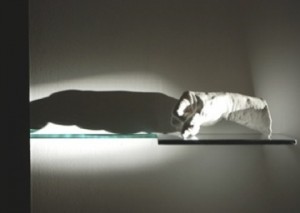
MPA: The entire piece initiated with me having the caste fist in my studio and letting light pour on to this object from the window with a sense of adding light to my relationship with my father. When approached for the show at Leo Koenig by Dean and Alhena, I had to answer, ‘Why take this private act into the public?’ I recognized that the directing of light could be a signaling of light, and began to observe the space in between the sun and the object that receives its light. This space in between had me looking at how a path of light (a signaling) may travel…direct and fragmented.
I have done performances that aggressively confront similar themes. The practice with light and the length of the show opened the possibility to elongate the conversation with “the fist”. In other words, I am not just smashing the fist. I am tracing light over its contours and making projections of its shadow. I held it for 2.5 hours at the opening “Initiation”. This feels like a study. An exercise. A ritual.
Ritual. (to do a series of actions to allow for a desire to manifest).
These acts are a way of knowing. To share this with a public is a manner of demonstration.
CM: How do you hope to see this show and the series of performances of which it is comprised understood through documentation after it has closed? Will there be any video documentation of any of the performances, and if not, do you have certain shots of your actions, for example, that you plan to get?
MPA: I have thought loads about documentation!! Thank you for asking. It has become increasingly important to me that the document of performance does not become an artifact of the event but that it has the opportunity to become an artwork itself. I have struggled with the often cold and distanced video recordings of my performances for several years due in large part to working with videographers that I don’t know and that don’t know my work. Myself along with the co-curators Alhena Katsof and Dean Daderko made a great effort to invite other artists and friends to video and photograph the activities as part of the exhibition. Sadie Benning video recorded the opening night “Initiation” and Emily Roysdon took photographs of a group of us last Sunday in “The Act”. I consider each of these to be collaborations and I feel very invested in their eye collecting the live material present in “Directing Light Onto Fist of Father”.
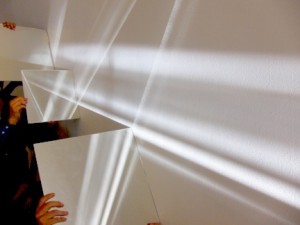
Emily Roysdon, 2011
For me it is about sharing a process or a way of looking. I had not worked with Sadie before, but I had an intuitive feeling about her. She is a really good observer both visually and sonically. When we sat down in the studio to talk about “Directing Light…” I wanted her to shoot 16mm. I was super focused on film because film is projected light, the life of film itself, that it deteriorates and gets scratched. Sadie asked me questions about why video or why film in relationship to the whole piece? She said she wasn’t interested in shooting film but was really into these tube cams. The tube cams are one of the first video cameras and have a distinct character with light. They burn an image into a light bulb. Often, when the camera looks at an image for over a minute it will keep that image in the frame when you move it to something else, overlaying the two. You might say it has a memory that happens in its mechanics, not just storing memory onto a tape. One thing I have been thinking about is what does it mean to have this tool that burns images and carries that image over into the next, especially when you are talking about something live. Perhaps, as Sadie suggested, the tube cams can show a way of capturing what is live in a way that is similar to the experience of looking at performance due to this blurring and fluidity of images between moments that occur inside the camera.
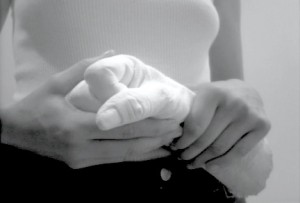
Sadie Benning, 2011
I have known Emily for nearly 8 years and I have found myself in front of her camera many times. Emily has a mind that is deep at work looking at the relationships that make up the social. She looks at the energy and politics alive in the spaces in between established and what she might call “imagined” relationships that are composed of individuals and groups. (She says this best, look at “Ecstatic Resistance”). Having been in Emily’s work but also having seen a lot of her work from a viewer’s perspective, I know Emily’s eye and also her joy when she is taking pictures. Specific to “Directing Light…” I mentioned to Emily the 16mm film project, “Desert Film”, that I directed in 2007 in the Mojave Desert. For that project she took incredible photos of light reflecting off jeweled masks worn by the performers. I expressed that I hoped we could get some of the same effects from the mirrors and sun in “The Act” of “Directing Light Onto Fist of Father”, and did we ever!!
In terms of your question about where these materials go after the show, that is still in discussion. But yes, sharing them publicly is part of the intention.











































































